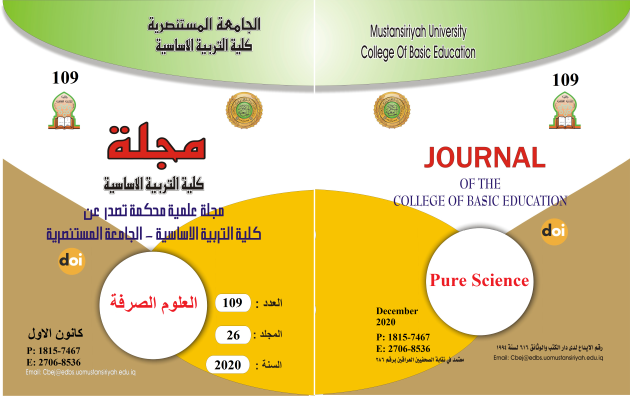Effect of Citric Acid on Some physiological Characteristics and the floral characteristics of Chamomile (Matricaria Chamomilla L.) at Increasing Concentrations of Kinetin
Main Article Content
Abstract
A field experiment was carried out in the Botanical Garden of the Science Department / College of Basic Education / University of Mustansiriya for the winter growth season 2018-2019 in order to find out the effect of concentrations increasing of Citric acid and growth regulator kinetin on some physiological characteristics and the floral characteristics of Chamomile (Matricaria Chamomilla L.). The experiment was designed according to Randomized Complete Block Design (RCBD) with three replicates, the results showed a significant increase when citric acid was added at a concentration of 10 mg. 1-liter in protein content of 40.05%, carbohydrate content 38.34%, chlorophyll A 20.19%, chlorophyll B 20.34%, total chlorophyll 21.17%, and number of flowering branches 25 The number of flowering inflorescences is 30.92% and the number of flowering inflorescences is 19.81% in the plant compared to control plants.
The spray also resulted in a concentration of 50 mg. L-1 from quinine to increase the percentage of protein 23.88%, carbohydrates 24.68%, chlorophyll A 34.54%, chlorophyll B 34.91%, total chlorophyll 35.64%, number of flowering branches 39.33%, number of flowering 19.69%, and flower yield 32.90% in plant compared to control plants.
in protein content of 40.05%, carbohydrate content 38.34%, chlorophyll A 20.19%, chlorophyll B 20.34%, total chlorophyll 21.17%, and number of flowering branches 25 The number of flowering inflorescences is 30.92% and the number of flowering inflorescences is 19.81% in the plant compared to control plants.
The spray also resulted in a concentration of 50 mg. L-1 from quinine to increase the percentage of protein 23.88%, carbohydrates 24.68%, chlorophyll A 34.54%, chlorophyll B 34.91%, total chlorophyll 35.64%, number of flowering branches 39.33%, number of flowering 19.69%, and flower yield 32.90% in plant compared to control plants.
in protein content of 40.05%, carbohydrate content 38.34%, chlorophyll A 20.19%, chlorophyll B 20.34%, total chlorophyll 21.17%, and number of flowering branches 25 The number of flowering inflorescences is 30.92% and the number of flowering inflorescences is 19.81% in the plant compared to control plants.
The spray also resulted in a concentration of 50 mg. L-1 from quinine to increase the percentage of protein 23.88%, carbohydrates 24.68%, chlorophyll A 34.54%, chlorophyll B 34.91%, total chlorophyll 35.64%, number of flowering branches 39.33%, number of flowering 19.69%, and flower yield 32.90% in plant compared to control plants.
Article Details

This work is licensed under a Creative Commons Attribution-ShareAlike 4.0 International License.
